maintenance TOYOTA GR86 2022 Owners Manual (in English)
[x] Cancel search | Manufacturer: TOYOTA, Model Year: 2022, Model line: GR86, Model: TOYOTA GR86 2022Pages: 582, PDF Size: 86.38 MB
Page 3 of 582
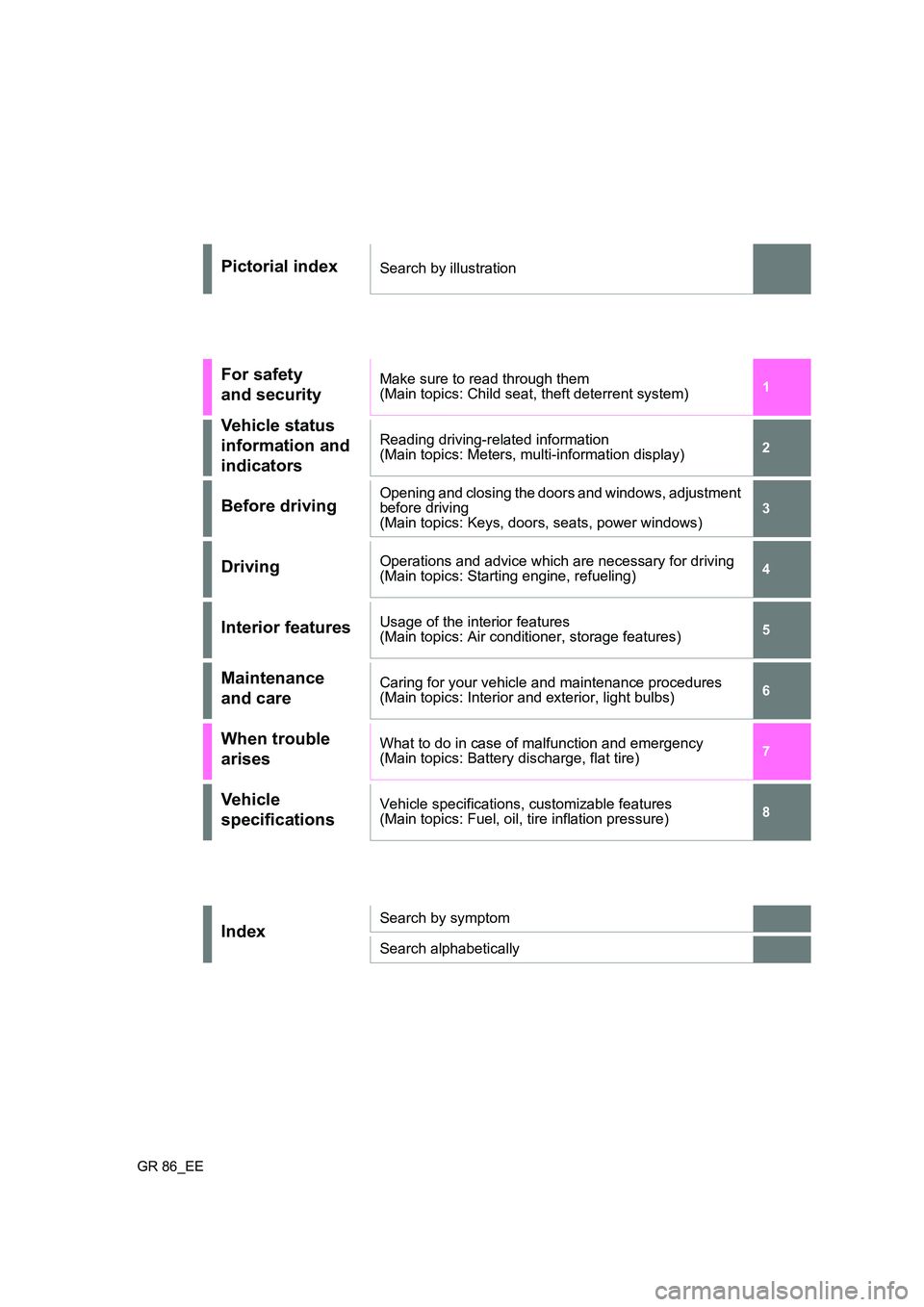
GR 86_EE
1
6
5
4
3
2
8
7
Pictorial indexSearch by illustration
For safety
and security
Make sure to read through them (Main topics: Child seat, theft deterrent system)
Vehicle status
information and
indicators
Reading driving-related information (Main topics: Meters, multi-information display)
Before drivingOpening and closing the doors and windows, adjustment before driving (Main topics: Keys, doors, seats, power windows)
DrivingOperations and advice which are necessary for driving (Main topics: Starting engine, refueling)
Interior featuresUsage of the interior features(Main topics: Air conditioner, storage features)
Maintenance
and care
Caring for your vehicle and maintenance procedures (Main topics: Interior and exterior, light bulbs)
When trouble
arises
What to do in case of malfunction and emergency (Main topics: Battery discharge, flat tire)
Ve h i c l e
specifications
Vehicle specifications, customizable features (Main topics: Fuel, oil, tire inflation pressure)
IndexSearch by symptom
Search alphabetically
Page 5 of 582
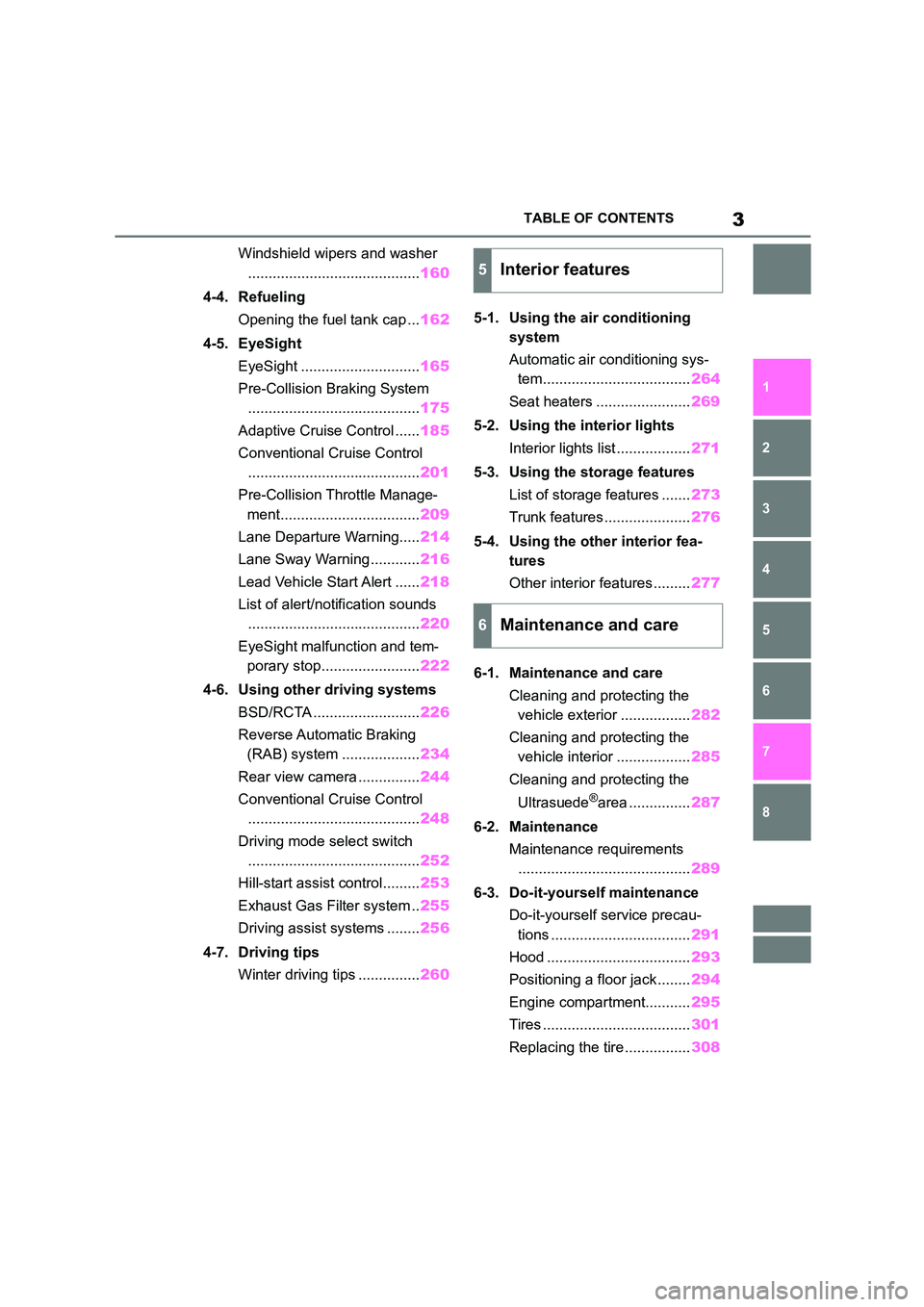
3TABLE OF CONTENTS
1
6
5
4
3
2
8
7
Windshield wipers and washer
.......................................... 160
4-4. Refueling
Opening the fuel tank cap ... 162
4-5. EyeSight
EyeSight ............................. 165
Pre-Collision Braking System
.......................................... 175
Adaptive Cruise Control ...... 185
Conventional Cruise Control
.......................................... 201
Pre-Collision Throttle Manage-
ment.................................. 209
Lane Departure Warning..... 214
Lane Sway Warning ............ 216
Lead Vehicle Start Alert ...... 218
List of alert/notification sounds
.......................................... 220
EyeSight malfunction and tem-
porary stop........................ 222
4-6. Using other driving systems
BSD/RCTA .......................... 226
Reverse Automatic Braking
(RAB) system ................... 234
Rear view camera ............... 244
Conventional Cruise Control
.......................................... 248
Driving mode select switch
.......................................... 252
Hill-start assist control......... 253
Exhaust Gas Filter system .. 255
Driving assist systems ........ 256
4-7. Driving tips
Winter driving tips ............... 260
5-1. Using the air conditioning
system
Automatic air conditioning sys-
tem.................................... 264
Seat heaters ....................... 269
5-2. Using the interior lights
Interior lights list .................. 271
5-3. Using the storage features
List of storage features ....... 273
Trunk features..................... 276
5-4. Using the other interior fea-
tures
Other interior features ......... 277
6-1. Maintenance and care
Cleaning and protecting the
vehicle exterior ................. 282
Cleaning and protecting the
vehicle interior .................. 285
Cleaning and protecting the
Ultrasuede®area ............... 287
6-2. Maintenance
Maintenance requirements
.......................................... 289
6-3. Do-it-yourself maintenance
Do-it-yourself service precau-
tions .................................. 291
Hood ................................... 293
Positioning a floor jack ........ 294
Engine compartment........... 295
Tires .................................... 301
Replacing the tire ................ 308
5Interior features
6Maintenance and care
Page 6 of 582

4TABLE OF CONTENTS
Tire inflation pressure .........312
Wheels ................................ 313
Air conditioning filter ........... 314
Electronic key battery ......... 316
Checking and replacing fuses
.......................................... 319
Light bulbs .......................... 321
7-1. Essential information
Emergency flashers ............ 326
If your vehicle has to be stopped
in an emergency ............... 326
If the vehicle is submerged or
water on the road is rising
.......................................... 327
7-2. Steps to take in an emergency
If your vehicle needs to be towed
.......................................... 329
If you think something is wrong
.......................................... 334
Fuel pump shut off system
.......................................... 335
If a warning light turns on or a
warning buzzer sounds ..... 336
If a warning message is dis-
played ............................... 344
If you have a flat tire ........... 345
If the engine will not start .... 355
If you lose your keys ........... 356
If the fuel filler door cannot be
opened.............................. 357
If the electronic key does not
operate properly ............... 357
If the vehicle battery is dis-
charged............................. 359
If your vehicle overheats ..... 362
If the vehicle becomes stuck
.......................................... 364
8-1. Specifications
Maintenance data (fuel, oil level,
etc.)................................... 368
Fuel information .................. 376
8-2. Customization
Customizable features ........ 377
What to do if... (Troubleshooting)
.......................................... 386
Alphabetical Index .............. 389
7When trouble arises
8Vehicle specifications
Index
Page 74 of 582
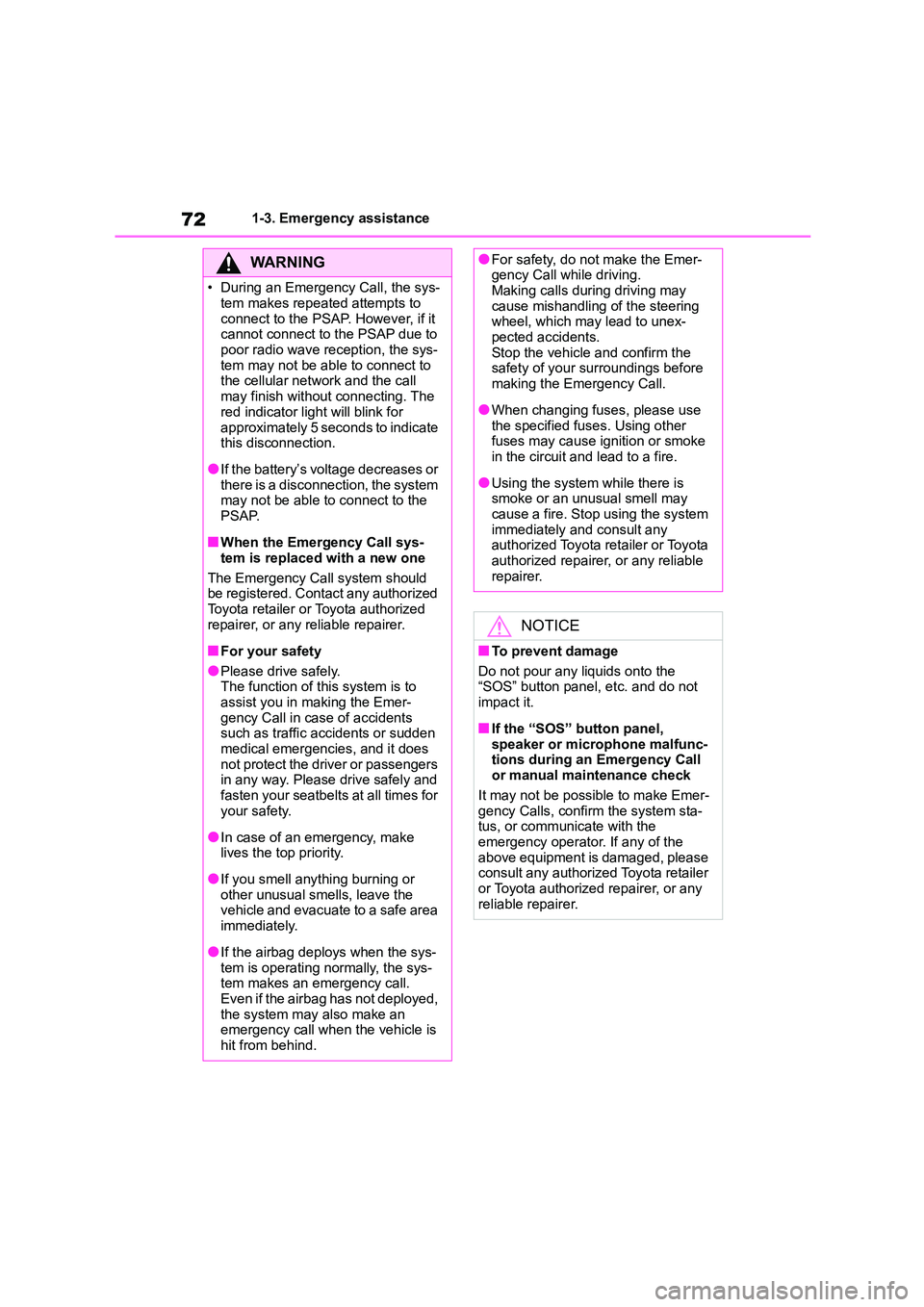
721-3. Emergency assistance
WA R N I N G
• During an Emergency Call, the sys-
tem makes repeated attempts to
connect to the PSAP. However, if it cannot connect to the PSAP due to
poor radio wave reception, the sys-
tem may not be able to connect to the cellular network and the call
may finish without connecting. The
red indicator light will blink for
approximately 5 seconds to indicate this disconnection.
●If the battery’s voltage decreases or there is a disconnection, the system
may not be able to connect to the
PSAP.
■When the Emergency Call sys-
tem is replaced with a new one
The Emergency Call system should
be registered. Contact any authorized
Toyota retailer or Toyota authorized repairer, or any reliable repairer.
■For your safety
●Please drive safely.
The function of this system is to
assist you in making the Emer- gency Call in case of accidents
such as traffic accidents or sudden
medical emergencies, and it does not protect the driver or passengers
in any way. Please drive safely and
fasten your seatbelts at all times for your safety.
●In case of an emergency, make lives the top priority.
●If you smell anything burning or other unusual smells, leave the
vehicle and evacuate to a safe area
immediately.
●If the airbag deploys when the sys-
tem is operating normally, the sys- tem makes an emergency call.
Even if the airbag has not deployed,
the system may also make an emergency call when the vehicle is
hit from behind.
●For safety, do not make the Emer- gency Call while driving.
Making calls during driving may
cause mishandling of the steering wheel, which may lead to unex-
pected accidents.
Stop the vehicle and confirm the safety of your surroundings before
making the Emergency Call.
●When changing fuses, please use
the specified fuses. Using other
fuses may cause ignition or smoke in the circuit and lead to a fire.
●Using the system while there is smoke or an unusual smell may
cause a fire. Stop using the system
immediately and consult any authorized Toyota retailer or Toyota
authorized repairer, or any reliable
repairer.
NOTICE
■To prevent damage
Do not pour any liquids onto the
“SOS” button panel, etc. and do not
impact it.
■If the “SOS” button panel,
speaker or microphone malfunc- tions during an Emergency Call
or manual maintenance check
It may not be possible to make Emer- gency Calls, confirm the system sta-
tus, or communicate with the
emergency operator. If any of the above equipment is damaged, please
consult any authorized Toyota retailer
or Toyota authorized repairer, or any reliable repairer.
Page 81 of 582
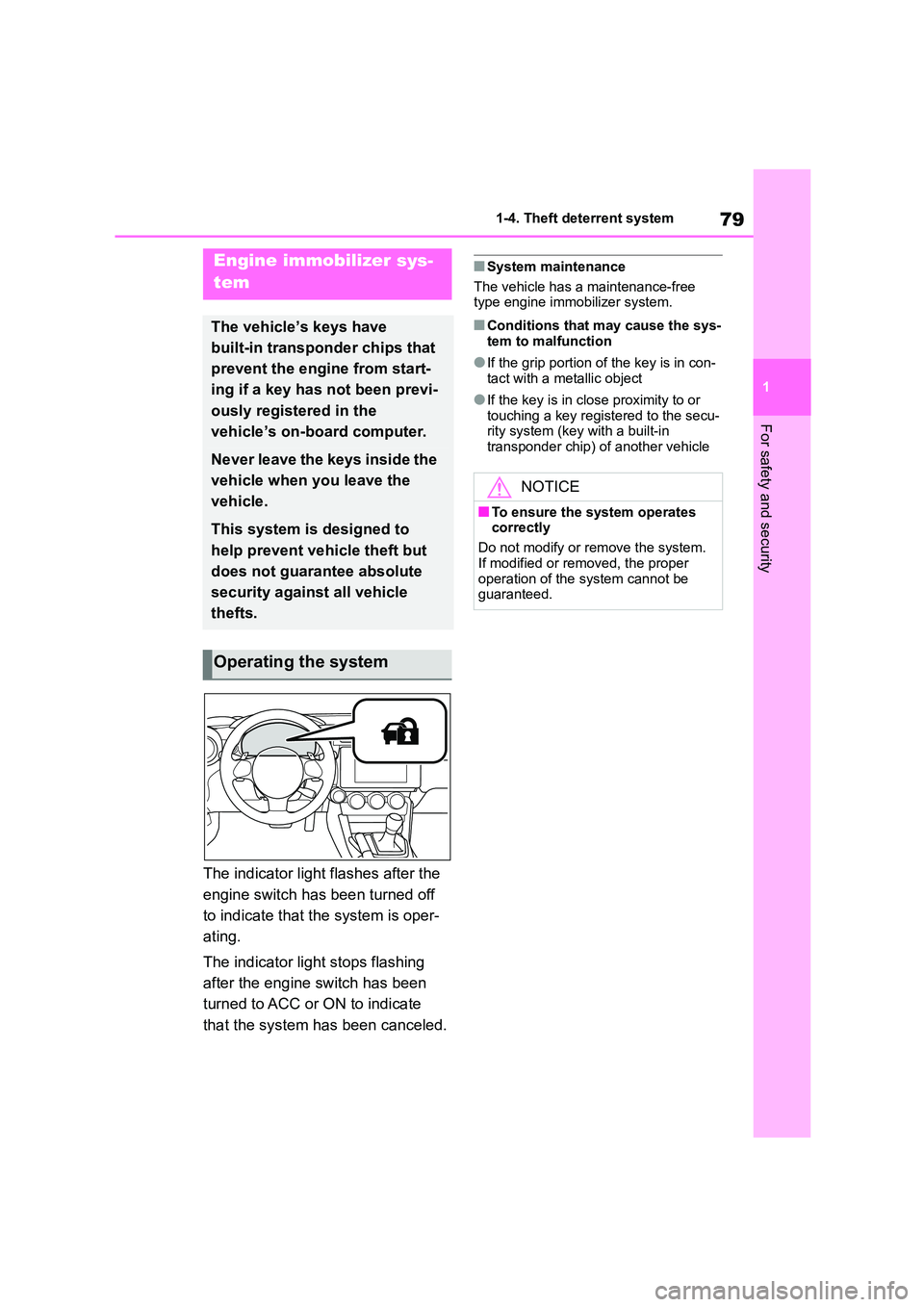
79
1
1-4. Theft deterrent system
For safety and security
1-4.Theft deterrent system
The indicator light flashes after the
engine switch has been turned off
to indicate that the system is oper-
ating.
The indicator light stops flashing
after the engine switch has been
turned to ACC or ON to indicate
that the system has been canceled.
■System maintenance
The vehicle has a maintenance-free
type engine immobilizer system.
■Conditions that may cause the sys-
tem to malfunction
●If the grip portion of the key is in con-
tact with a metallic object
●If the key is in close proximity to or
touching a key registered to the secu- rity system (key with a built-in
transponder chip) of another vehicle
Engine immobilizer sys-
tem
The vehicle’s keys have
built-in transponder chips that
prevent the engine from start-
ing if a key has not been previ-
ously registered in the
vehicle’s on-board computer.
Never leave the keys inside the
vehicle when you leave the
vehicle.
This system is designed to
help prevent vehicle theft but
does not guarantee absolute
security against all vehicle
thefts.
Operating the system
NOTICE
■To ensure the system operates
correctly
Do not modify or remove the system.
If modified or removed, the proper
operation of the system cannot be guaranteed.
Page 84 of 582
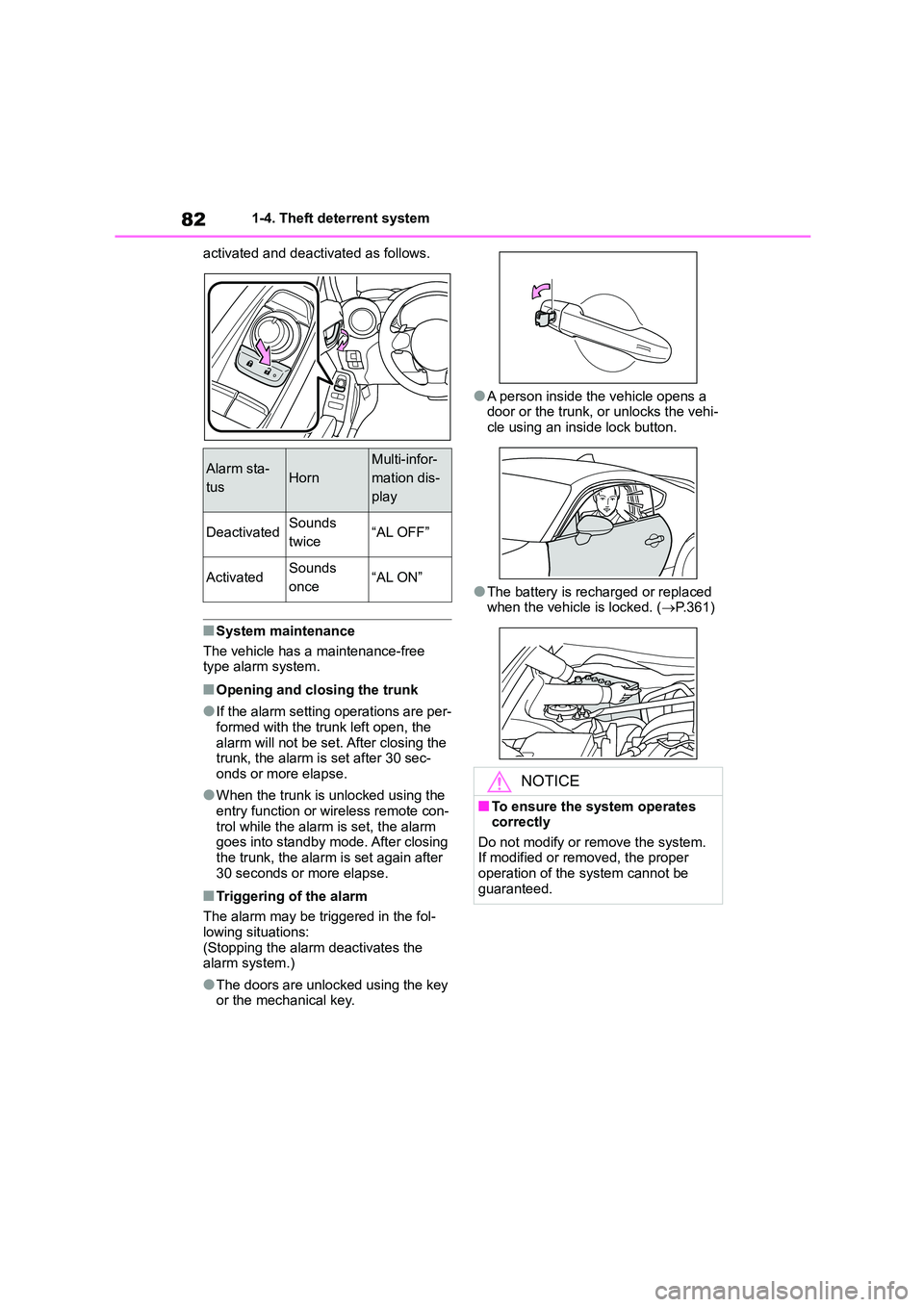
821-4. Theft deterrent system
activated and deactivated as follows.
■System maintenance
The vehicle has a maintenance-free
type alarm system.
■Opening and closing the trunk
●If the alarm setting operations are per-
formed with the trunk left open, the
alarm will not be set. After closing the trunk, the alarm is set after 30 sec-
onds or more elapse.
●When the trunk is unlocked using the
entry function or wireless remote con-
trol while the alarm is set, the alarm goes into standby mode. After closing
the trunk, the alarm is set again after
30 seconds or more elapse.
■Triggering of the alarm
The alarm may be triggered in the fol- lowing situations:
(Stopping the alarm deactivates the
alarm system.)
●The doors are unlocked using the key
or the mechanical key.
●A person inside the vehicle opens a
door or the trunk, or unlocks the vehi- cle using an inside lock button.
●The battery is recharged or replaced when the vehicle is locked. ( P.361)
Alarm sta-
tusHorn
Multi-infor-
mation dis-
play
DeactivatedSounds
twice“AL OFF”
ActivatedSounds
once“AL ON”
NOTICE
■To ensure the system operates
correctly
Do not modify or remove the system. If modified or removed, the proper
operation of the system cannot be
guaranteed.
Page 178 of 582
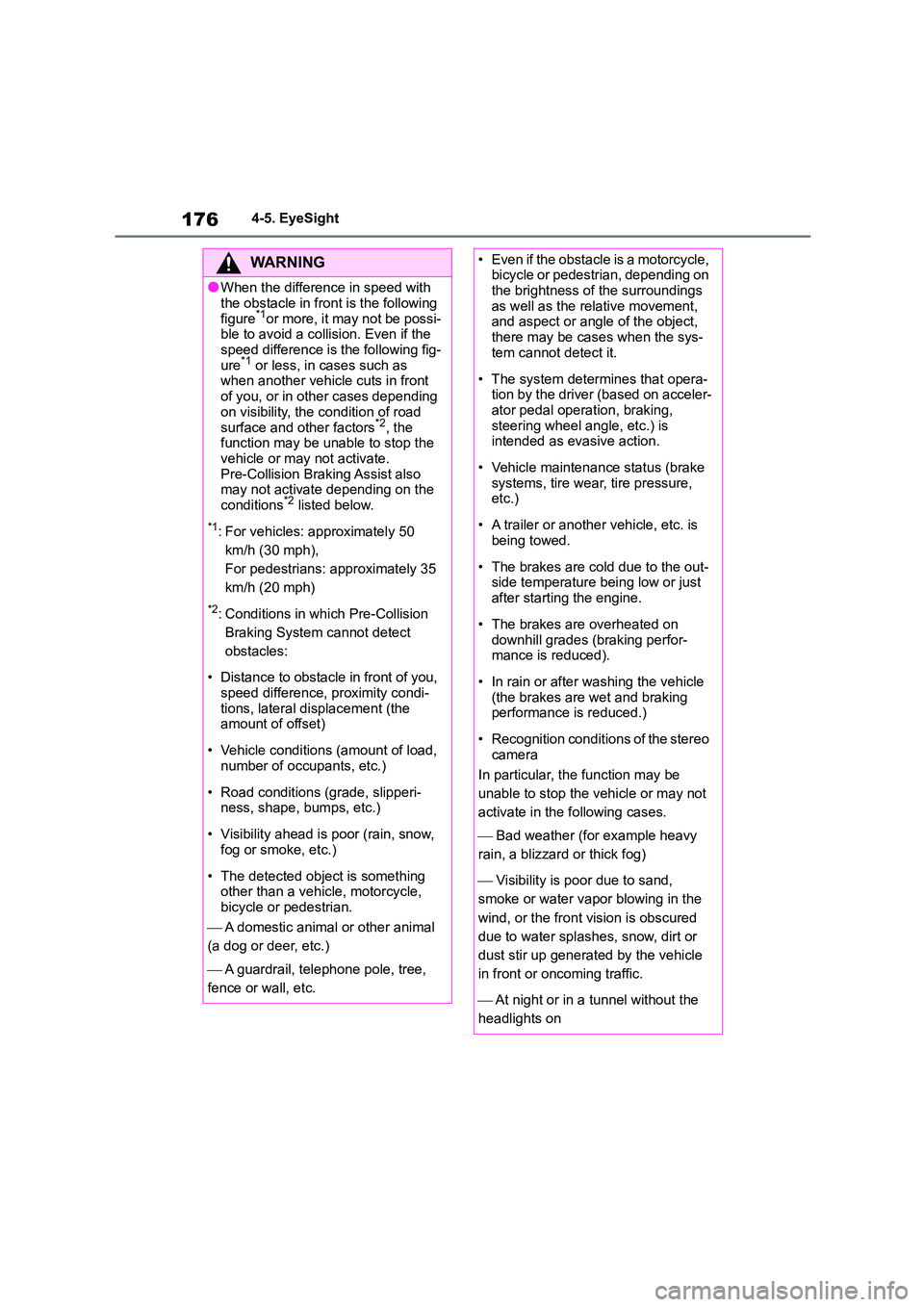
1764-5. EyeSight
WA R N I N G
●When the difference in speed with
the obstacle in front is the following
figure*1or more, it may not be possi- ble to avoid a collision. Even if the
speed difference is the following fig-
ure*1 or less, in cases such as when another vehicle cuts in front
of you, or in other cases depending
on visibility, the condition of road
surface and other factors*2, the function may be unable to stop the
vehicle or may not activate.
Pre-Collision Braking Assist also may not activate depending on the
conditions*2 listed below.
*1: For vehicles: approximately 50
km/h (30 mph),
For pedestrians: approximately 35
km/h (20 mph)
*2: Conditions in which Pre-Collision
Braking System cannot detect
obstacles:
• Distance to obstacle in front of you,
speed difference, proximity condi- tions, lateral di splacement (the
amount of offset)
• Vehicle conditions (amount of load,
number of occupants, etc.)
• Road conditions (grade, slipperi-
ness, shape, bumps, etc.)
• Visibility ahead is poor (rain, snow,
fog or smoke, etc.)
• The detected object is something
other than a vehi cle, motorcycle,
bicycle or pedestrian.
A domestic animal or other animal
(a dog or deer, etc.)
A guardrail, telephone pole, tree,
fence or wall, etc.
• Even if the obstacle is a motorcycle, bicycle or pedestrian, depending on
the brightness of the surroundings
as well as the relative movement, and aspect or angle of the object,
there may be cases when the sys-
tem cannot detect it.
• The system determines that opera-
tion by the driver (based on acceler- ator pedal operation, braking,
steering wheel angle, etc.) is
intended as evasive action.
• Vehicle maintenance status (brake
systems, tire wear, tire pressure, etc.)
• A trailer or another vehicle, etc. is being towed.
• The brakes are cold due to the out- side temperature being low or just
after starting the engine.
• The brakes are overheated on
downhill grades (braking perfor-
mance is reduced).
• In rain or after washing the vehicle
(the brakes are wet and braking performance is reduced.)
• Recognition conditions of the stereo camera
In particular, the function may be
unable to stop the vehicle or may not
activate in the following cases.
Bad weather (for example heavy
rain, a blizzard or thick fog)
Visibility is poor due to sand,
smoke or water vapor blowing in the
wind, or the front vision is obscured
due to water splashes, snow, dirt or
dust stir up generated by the vehicle
in front or oncoming traffic.
At night or in a tunnel without the
headlights on
Page 192 of 582
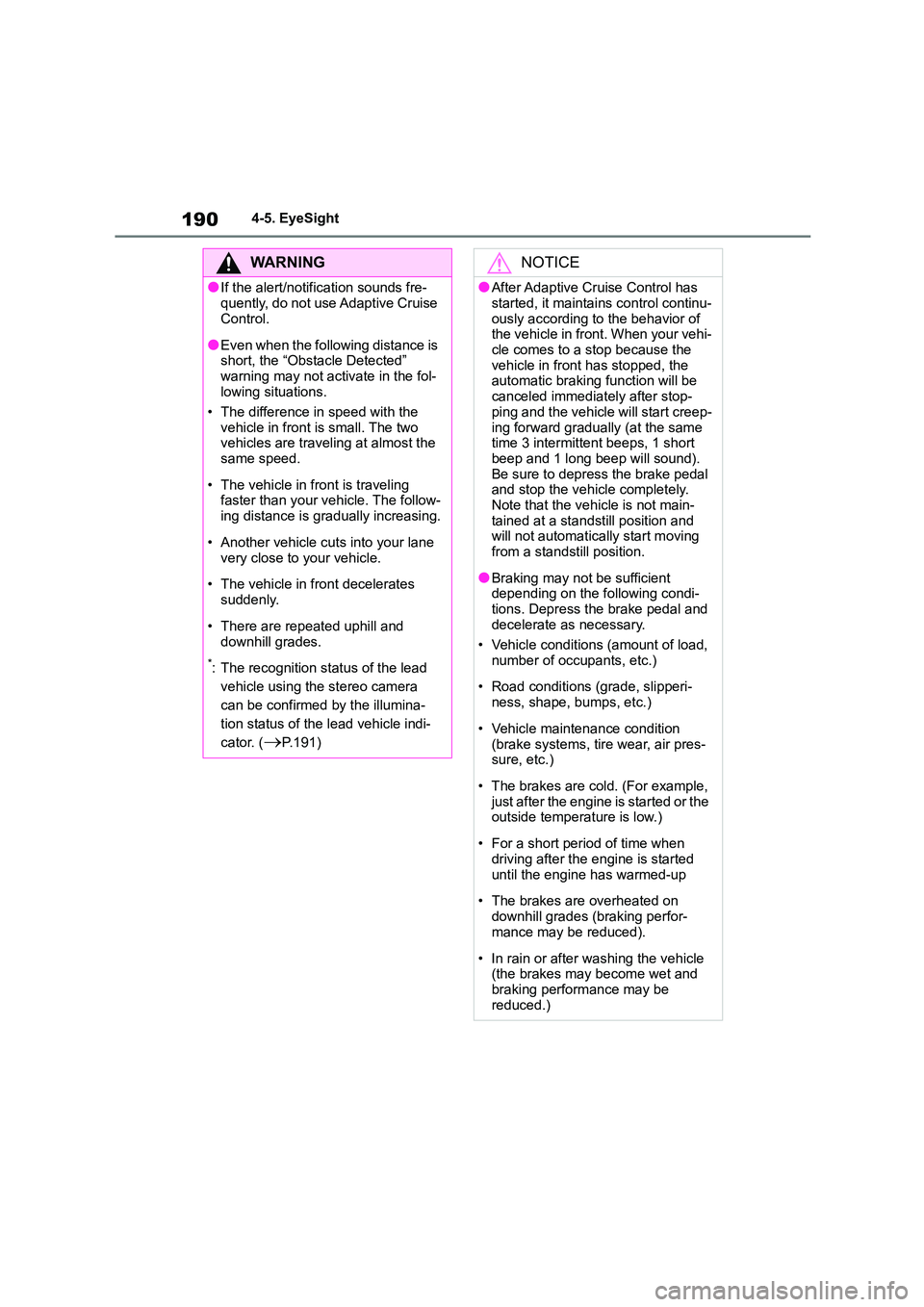
1904-5. EyeSight
WA R N I N G
●If the alert/notification sounds fre-
quently, do not use Adaptive Cruise
Control.
●Even when the following distance is
short, the “Obstacle Detected” warning may not activate in the fol-
lowing situations.
• The difference in speed with the
vehicle in front is small. The two vehicles are traveling at almost the
same speed.
• The vehicle in front is traveling
faster than your vehicle. The follow-
ing distance is gradually increasing.
• Another vehicle cuts into your lane
very close to your vehicle.
• The vehicle in front decelerates
suddenly.
• There are repeated uphill and
downhill grades.
*: The recognition status of the lead
vehicle using the stereo camera
can be confirmed by the illumina-
tion status of the lead vehicle indi-
cator. (P.191)
NOTICE
●After Adaptive Cruise Control has
started, it maintains control continu-
ously according to the behavior of the vehicle in front. When your vehi-
cle comes to a stop because the
vehicle in front has stopped, the automatic braking function will be
canceled immediately after stop-
ping and the vehicle will start creep-
ing forward gradually (at the same time 3 intermittent beeps, 1 short
beep and 1 long beep will sound).
Be sure to depress the brake pedal and stop the vehicle completely.
Note that the vehicle is not main-
tained at a standstill position and will not automatica lly start moving
from a standstill position.
●Braking may not be sufficient
depending on the following condi-
tions. Depress the brake pedal and decelerate as necessary.
• Vehicle conditions (amount of load,
number of occupants, etc.)
• Road conditions (grade, slipperi-
ness, shape, bumps, etc.)
• Vehicle maintenance condition
(brake systems, tire wear, air pres- sure, etc.)
• The brakes are cold. (For example, just after the engine is started or the
outside temperature is low.)
• For a short period of time when
driving after the engine is started
until the engine has warmed-up
• The brakes are overheated on
downhill grades (braking perfor- mance may be reduced).
• In rain or after washing the vehicle (the brakes may become wet and
braking performance may be
reduced.)
Page 283 of 582
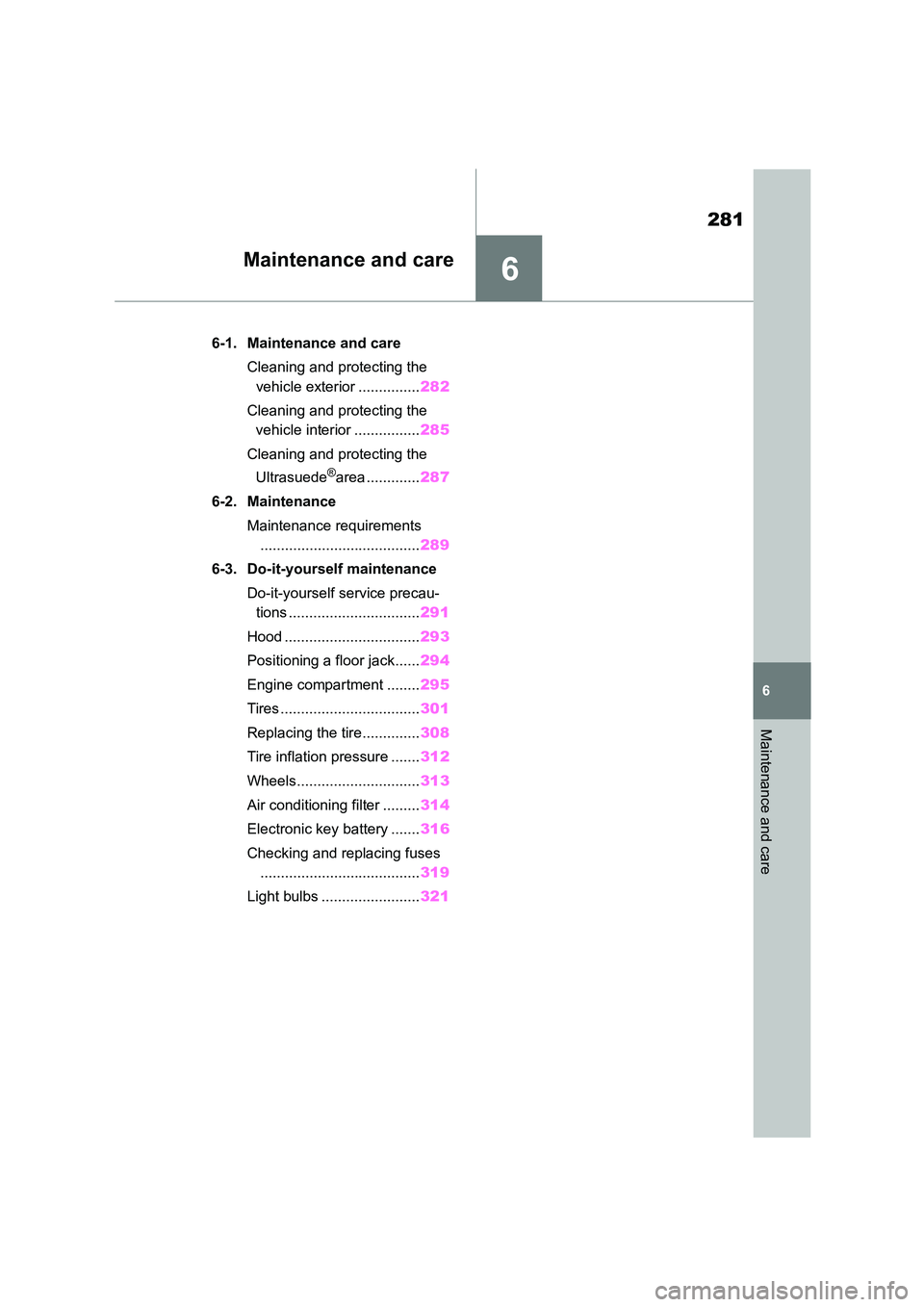
6
281
6
Maintenance and care
Maintenance and care
.6-1. Maintenance and care
Cleaning and protecting the
vehicle exterior ............... 282
Cleaning and protecting the
vehicle interior ................ 285
Cleaning and protecting the
Ultrasuede®area ............. 287
6-2. Maintenance
Maintenance requirements
....................................... 289
6-3. Do-it-yourself maintenance
Do-it-yourself service precau-
tions ................................ 291
Hood ................................. 293
Positioning a floor jack ...... 294
Engine compartment ........ 295
Tires .................................. 301
Replacing the tire.............. 308
Tire inflation pressure ....... 312
Wheels.............................. 313
Air conditioning filter ......... 314
Electronic key battery ....... 316
Checking and replacing fuses
....................................... 319
Light bulbs ........................ 321
Page 284 of 582
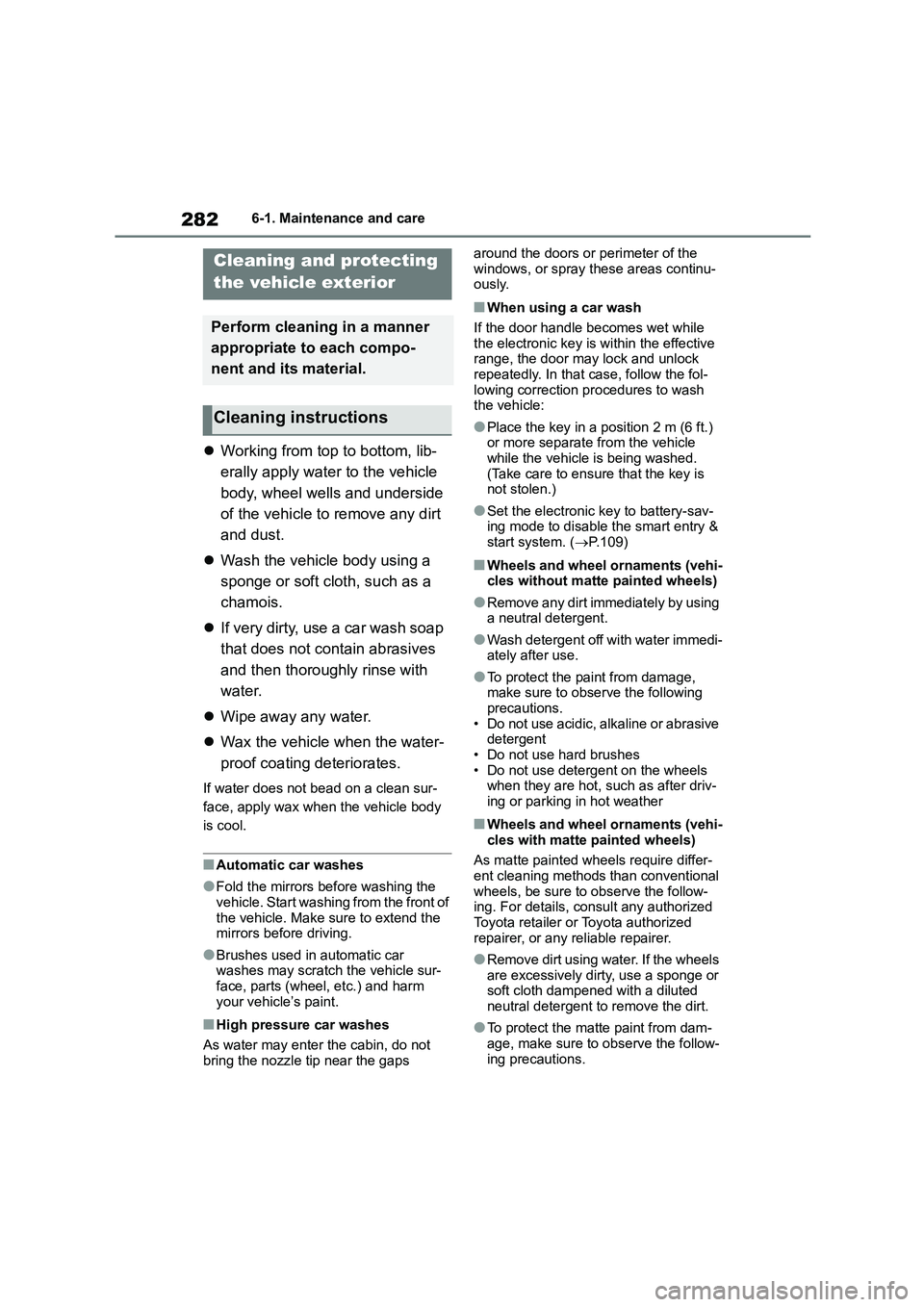
2826-1. Maintenance and care
6-1.Maintenance and care
Working from top to bottom, lib-
erally apply water to the vehicle
body, wheel wells and underside
of the vehicle to remove any dirt
and dust.
Wash the vehicle body using a
sponge or soft cloth, such as a
chamois.
If very dirty, use a car wash soap
that does not contain abrasives
and then thoroughly rinse with
water.
Wipe away any water.
Wax the vehicle when the water-
proof coating deteriorates.
If water does not bead on a clean sur-
face, apply wax when the vehicle body
is cool.
■Automatic car washes
●Fold the mirrors before washing the
vehicle. Start washing from the front of
the vehicle. Make sure to extend the mirrors before driving.
●Brushes used in automatic car washes may scratch the vehicle sur-
face, parts (wheel, etc.) and harm
your vehicle’s paint.
■High pressure car washes
As water may enter the cabin, do not
bring the nozzle tip near the gaps
around the doors or perimeter of the
windows, or spray these areas continu- ously.
■When using a car wash
If the door handle becomes wet while
the electronic key is within the effective range, the door may lock and unlock
repeatedly. In that case, follow the fol-
lowing correction procedures to wash the vehicle:
●Place the key in a position 2 m (6 ft.) or more separate from the vehicle
while the vehicle is being washed.
(Take care to ensure that the key is not stolen.)
●Set the electronic key to battery-sav-ing mode to disable the smart entry &
start system. ( P.109)
■Wheels and wheel ornaments (vehi-
cles without matte painted wheels)
●Remove any dirt immediately by using
a neutral detergent.
●Wash detergent off with water immedi-
ately after use.
●To protect the paint from damage,
make sure to observe the following precautions.
• Do not use acidic, alkaline or abrasive
detergent • Do not use hard brushes
• Do not use detergent on the wheels
when they are hot, such as after driv- ing or parking in hot weather
■Wheels and wheel ornaments (vehi-
cles with matte painted wheels)
As matte painted wheels require differ- ent cleaning methods than conventional
wheels, be sure to observe the follow-
ing. For details, consult any authorized
Toyota retailer or Toyota authorized repairer, or any reliable repairer.
●Remove dirt using water. If the wheels are excessively dirty, use a sponge or
soft cloth dampened with a diluted
neutral detergent to remove the dirt.
●To protect the matte paint from dam-
age, make sure to observe the follow- ing precautions.
Cleaning and protecting
the vehicle exterior
Perform cleaning in a manner
appropriate to each compo-
nent and its material.
Cleaning instructions